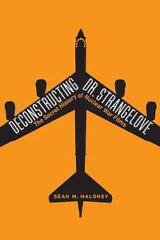 The Cold War, with all of its threats and visions of mass destruction and apocalyptic scenarios appears far away these days. However, when the menace of nuclear weapons that possibly would be fired if wrong decisions were made by a few incompetent men in the military back in the 1960s, stories, novels and mostly movies were the main source of information and also advance panic.
The Cold War, with all of its threats and visions of mass destruction and apocalyptic scenarios appears far away these days. However, when the menace of nuclear weapons that possibly would be fired if wrong decisions were made by a few incompetent men in the military back in the 1960s, stories, novels and mostly movies were the main source of information and also advance panic.
Those works were basically either informative, came disguised as action or spy thrillers, or combined all of that together with humor, irony and absurd plots, as did Stanley Kubrick‘s Dr. Strangelove or: How I Learned to Stop Worrying and Love the Bomb from 1964.
Throughout the 1950s, many science fiction and horror movies made the American public aware of the effects of nuclear bomb tests, fallout, and consequently, mutations for man and animals alike, diseases as well as strange powers or fantastic growth. The nation knew that this sort of weapon was extremely dangerous; that was one main message. In the movies, nevertheless, man and the military were always able to handle that power and would use it wisely to fight aliens, intruders or monsters; usually, the fear of a worldwide thermonuclear war was not even mentioned.
Dr. Strangelove, on the other hand, would illustrate how easily an atomic bomb strike could become reality. While the movies of the 1950s usually would give the small (and small town) perspective on nuclear warfare, Kubrick’s film would show how things could get out of hand, and what it meant for the entire planet. His movie would thereby completely ridicule the military’s so-called “fail-safe” concept; a theory would prevent mistakes and erroneous decisions of those capable of releasing atomic missiles.
On almost 500 pages, Sean M. Maloney interprets Dr. Strangelove (as well the pictures Fail-Safe, On the Beach, By Dawn’s Early Light, and others) in terms of realism and representations of the contemporary state-of mind. In fact, movies with an emphasis on B52 bomber pilots or tales of nuclear Armageddon were so popular, that they defined their own genre, namely the Cold War nuclear crisis film. Dr. Strangelove is “the flagship” of those movies, “… many of which are employed in academic venues to depict the prime absurdity of the Cold War: nuclear deterrence and its possible failure.”
In reality, no general hit the button and the planet was not destroyed. This is the result of a number of positive developments, some are directly related to popular culture and its products. “The nuclear war films were arguably part of why a war didn’t happen and what the results might look like. … And it is evident from newly released material that Ronald Reagan was tremendously and personally affected by the 1983 TV movie The Day After and that this influenced policy in a positive fashion.”
Maloney’s approach differs significantly from that of film historians. He is a professor of history at the Royal Military College of Canada, served as the Canadian Army’s historian for the war in Afghanistan from 2003 to 2014 and has published several books on military topics.
His mix of very detailed information on army and navy military strategies, nuclear and ballistic weapons ranges, their functions and capabilities, his knowledge about chains of command, locations of missile bases and a seemingly endless repertoire of Cold War incidents and strategic decisions make Deconstructing Dr. Strangelove extremely valuable. The Strategic Air Command bomber force and nuclear submarines that both play an important part in the movies discussed here, receive extra attention.
At times one wonders how the White House and Air Force staff would have many severe situations under control for decades, particularly if one considers the critical mental stability assigned to most of the senior military personnel in the movies. Maloney also shows that the films, even if they had a role in preventing an atomic war, often oversimplified, mislead audiences how nuclear deterrent mechanisms worked, sensationalized and basically neglected the global political situations and nations that employed atomic missiles to protect antidemocratic and occupational interests.
He meticulously displays the “very big picture,” relating various substantial incidents such as the Cuban Missile Crisis or the Kennedy assassination as well as smaller historical events such as newspaper articles, cartoons, novels and social changes in the country to the history of nuclear threats. Furthermore, the zeitgeist and other forms of popular statements on the Cold War in the media, TV, or on the radio, are added here with great skill and are presented in a straightforward manner without sounding too scholarly or informed by heavy academic film theory or sociology.
Very informative and capturing.
Review by Dr. A. Ebert © 2021
Sean M. Maloney. Deconstructing Dr. Strangelove: The Secret History of Nuclear War Films. Potomac Books (University of Nebraska Press), 2020, 498p.
